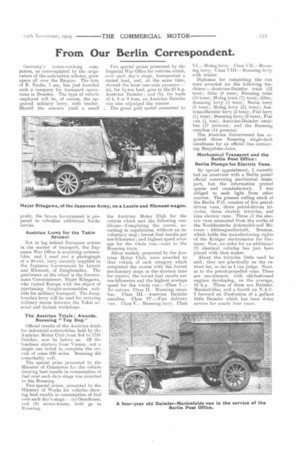From Our Berlin Correspondent.
Page 3

If you've noticed an error in this article please click here to report it so we can fix it.
Germany's motor-IA oiling companies, as contemplated by the originators of the subvention scheme, grow apace all over the Empire. The firm of E. Nacke, I see, has just founded such a company for transport operations in Dresden. The type of vehicle employed will be, of course, the approved military lorry, with trailer. Should the concern yield a small profit, the Saxon Government is prepared to subsidise additional Nacke lorries.
Austrian Lorry for the Tokio Arsenal.
Not to lag behind European armies in the matter of transport, the Japanese War Office is acquiring automoInks, and I send you a photograph of a 30-cwt. lorry recently supplied to the Japanese Government by Laurin and Klement, of Jungbunzlau. The gentleman at the wheel is the Government Commissioner, Nlajor Kitagawa, who visited Europe with the object of purchasing freight-automobiles suitable for military transport. The ungbunzlau lorry will be used for carrying military stores between the Tokio arsenal and distant workshops.
The Austrian Trials : Awards. Buessing " Top Dog."
Official results of the Austrian trials for industrial automobiles, held by the Austrian Motor Club from 3rd to 17th October. now lie before us. Of the fourteen starters from Vienna, not a single one failed to complete the circuit of some 690 miles. Buessing did remarkably well. The special prize presented by the Minister of Commerce kr the vehicle showing best results in consumption of fuel over each days stage was awarded to the Buessing.
Two special prizes, presented by the Ministry of Works for vehicles showing best results in consumption of fuel over each day's stage (a) Omnibuses, and (h) motor-trains. both go to tessiug. Two special prizes presented by the Imperial War Office for vehicles which, over each day's stage, transported a stated load, and, at the same time, showed the least rear-axle pressure :-(a), for 1-ton load, goes to the 20 h.p. Austrian Daimler ; and (b), for loads of 4, 6 or 8 tons, an Austrian Daimler was also adjudged the winner. The great gold medal presented by
the Austrian Motor Club for the vehicle which met the following conditions—Completing the course, according to regulations, without an involuntary stop ; lowest fuel results per ton-kilometre; and highest speed average for the whole run—went to the Buessing train. Silver medals, presented by the Austrian Motor Club, were awarded to that vehicle of each category which completed the course with the fewest involuntary stops or the shortest time for repairs, the lowest fuel results per ton-kilometre and the highest average speed for the whole run :—Class I.— No entries. Class II. -Tiueasing omnibus. Class III.—Austrian Daimler omnibus. Class IV.—Fiat delivery van. Class V.—Buessing lorry. Class VI.—Mulag lorry. Clam VI I.-13u eN8ing lorry. Class VIII.—Buessing lorry with trailer.
Diplomas for completing the run were awarded for the following machines :—Austrian-Daimler train (12 tons); ditto (9 tons); Buessing train (10 tons); Mulag train (74 tons); ditto ; ilueming lorry (5 tons); Berns, lorry (5 tons); Ilulag lorry (21tons); Austrian-Daimler lorry (2 tons); Fiat lorry (14, tons); Buessing lorry (2 tons); Fiat van (, ton); Austrian-Daimler omnibus (17 persons); and the Buessing omnibus (14 persons).
The Austrian Government has acquired three Buessing single-deck omnibuses for an official line connecting Banjaluka-jaice.
Mechanical Transport and the Berlin Post Office : Berlin Plumps for Electric Vans.
By special appointment, I recently had an interview with a Berlin postal official concerning mechanical transport, but the information proved sparse and unsatisfactory_ I was obliged to seek light from other sources. The present rolling stock of the Berlin P.O. consists of five petroldriven vans, three petrol-driven tricycles, three electric trieycles, and nine electric vans. Three cf the electric vans emanated from the works of the Norddeutsche Automohil-und Motoren Aktiengesellschaft, Bremen, which holds the manufacturing rights of the Krieger electromotor for Germany. Now, an order for an additional 25 identical vehicles has just been placed with that maker.
About the tricycles little need be said; they are practically on the retired list, so far as I can judge. Next, as to the petrol-propelled vans. These are one-tonners, with old-fashioned engines developing, on the average, 10 h.p. Three of them are DaimlerMarienfeldes, and a fourth an N.A.C. 1 forward an illustration of a gallant little Daimler which has been doing service for nearly four years.




















